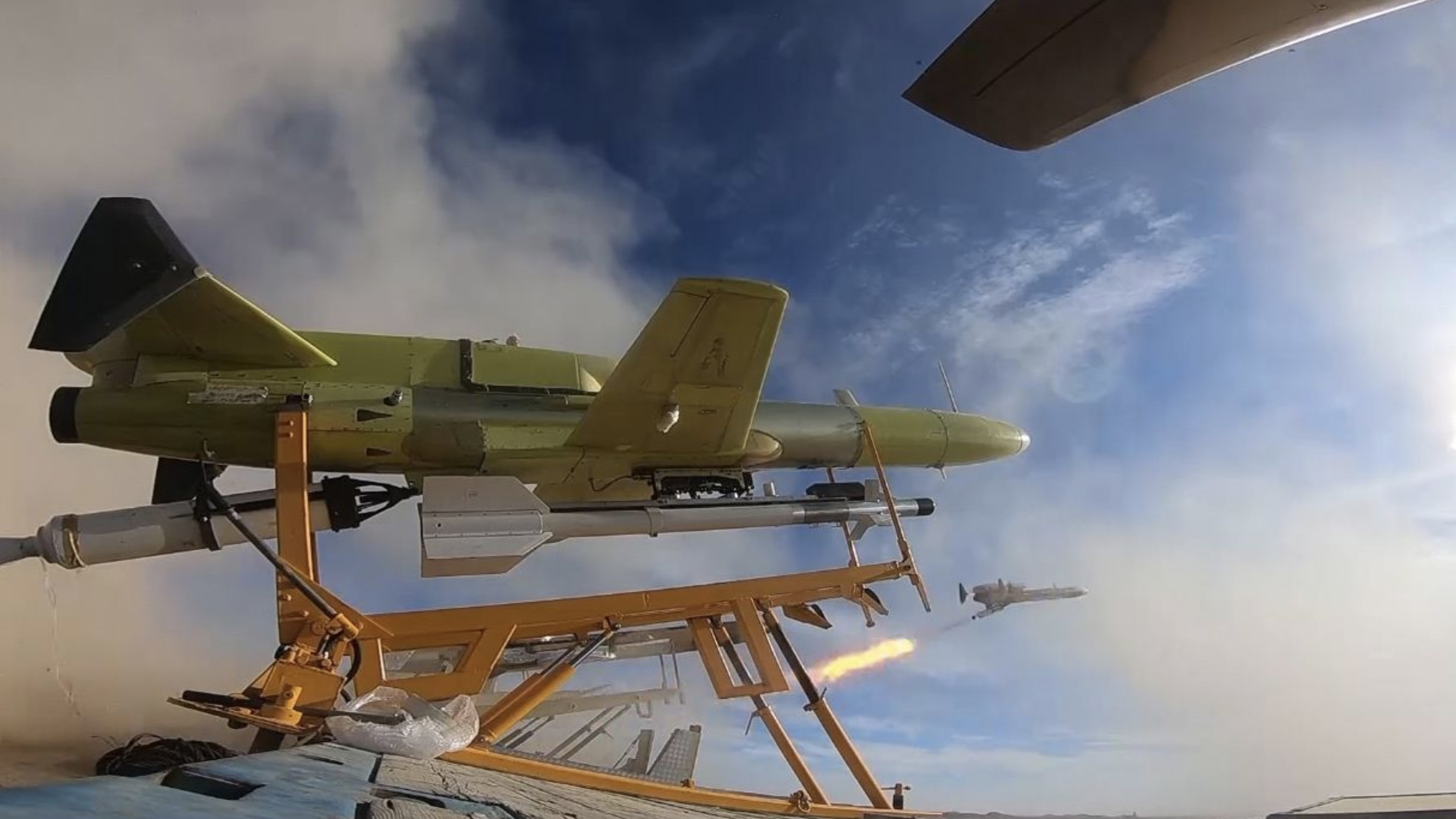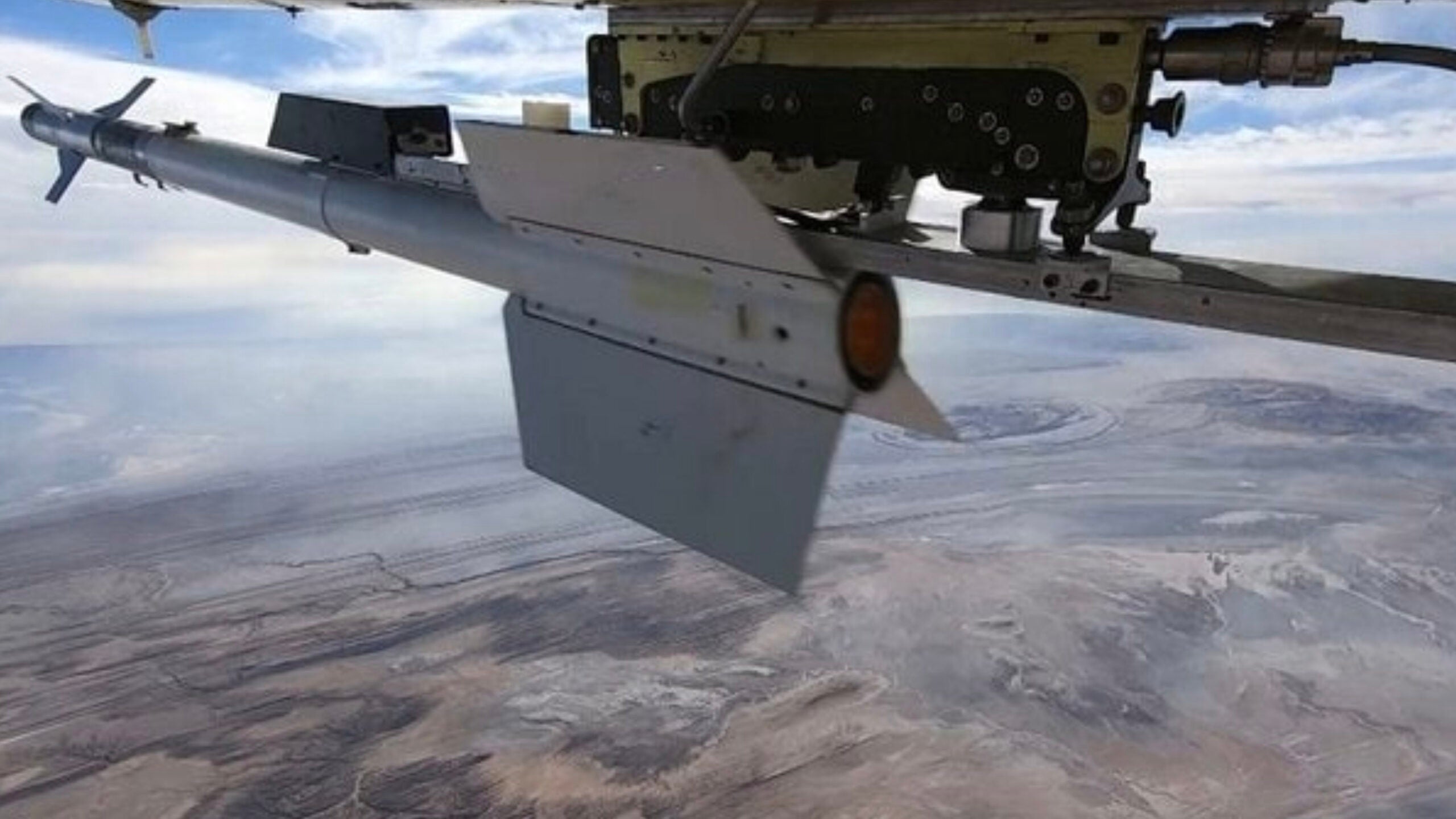Video footage shows that Iran has fired its enigmatic Azarakhsh missile, which was originally claimed to be a combination anti-tank and short-range surface-to-air weapon, from an unmanned aerial vehicle during a recent series of drone-based war games. Imagery taken during the maneuvers clearly shows one of the Sidewinder lookalikes being launched from under the belly of a Karrar drone after the latter took off from a truck-mounted launcher.
According to a report today from Iran’s semi-official Mehr news agency, the Karrar “interceptor drone” operated by the Islamic Republic of Iran’s Air Defense Force used the Azarakhsh to destroy aerial targets during the second day of the exercise. At the time of writing, there does not appear to be any video or pictures showing missiles fired by Karrar drones actually hitting anything.

The exact nature of the Azarakhsh missile remains something of a mystery, but The War Zone looked into the background of the story in this previous article. Suffice to say, the weapon appears to be at least a derivative of the U.S.-made AIM-9 Sidewinder air-to-air missile, thousands of which were delivered to Iran before the revolution that ousted the Shah in 1979.
While the Sidewinder is best-known as an air-to-air weapon, the basic design has also been adapted by the United States for air-to-ground use in the past, while surface-launched derivatives have also been produced for land-based and naval applications. With that in mind, it’s not clear whether the drone-launched Azarakhsh is now intended to defeat aerial threats or whether it can strike targets on the ground, too.
When the Islamic Revolutionary Guard Corps, or IRGC, unveiled the Azarakhsh it was described as a weapon for helicopters and ground-based launchers, but there was no suggestion it would be adapted for drones, too.
The video below shows the public debut of the Azarakhsh missile in 2018.

However, as The War Zone pointed out when the Azarakhsh first appeared, it would make sense for the weapon to retain at least some capability to engage relatively low- or slow-flying aircraft, including helicopters or small drones. Mehr news agency described the target used in the exercise as having “low radar cross-section,” but provided no additional details or supporting imagery. Even if it was, this is probably of little relevance to the Azarakhsh’s reported infrared guidance system.
Other combat drones took part in the drills as well, including examples of the Karrar armed with 500-pound Mk 82 unguided bombs. This combination, in contrast to the Azarakhsh-armed Karrar, had been seen during previous maneuvers last September.
Revealed in 2010, the Karrar unmanned aerial vehicle is produced by the Iran Aircraft Manufacturing Industrial Company and has a reported maximum range of around 620 miles. It is launched using a rocket booster and is recovered by parachute.
Another novelty of the latest exercise appears to be a version of the Karrar unmanned aerial vehicle fitted with an infrared sensor in the nose. While the function of this is not certain, unconfirmed reports suggest that it converts the drone into a “suicide interceptor,” destroying an aerial target much like a heat-seeking missile, although this would only be a practical solution against slow-moving, non-maneuvering targets. On the other hand, a missile-based self-defense capability for a drone, however clumsy, presents a much higher risk to any aircraft that might be intercepting it.
By outfitting its Karrar drone as a missile-armed interceptor, Iran seems to be at least indicating a desire to join a select group of countries that are adopting unmanned aerial vehicles with air-to-air capabilities. Russia’s Okhotnik unmanned combat air vehicle (UCAV) was reportedly flight-tested with air-to-air missiles for the first time late last year, a development you can read more about here. In that instance, however, no weapons were actually launched.
In the United States, meanwhile, these types of developments stretch back to at least 2003, including the arming of the now-retired MQ-1 Predators with Stingers to defend themselves against Iraqi fighters during Operation Iraqi Freedom and, more recently, tests of MQ-9 Reapers armed with AIM-9X Sidewinders. The U.S. Air Force is also working toward fielding loyal wingman-type drones that will be able to carry air-to-ground, and potentially air-to-air, weapons. This is in addition to what are almost certainly classified test and developmental UCAV programs, the potential existence and implications of which you can read all about here.
Ironically, Iran’s own activity was a spur to the United States reinstating a self-defense capability to its combat drones. In the last decade or so, American drones have been harassed repeatedly by the Iranians while on patrols over the Persian Gulf. At one stage, F-22 stealth fighters were required to send a message to the crews of Iranian jet crews to leave alone unmanned aircraft operating in international airspace in the region.
Rear Admiral Seyed Mahmoud Mousavi, the spokesman for the drone training exercise, told the Mehr news agency that the “army of the Islamic Republic of Iran is able to respond to any enemy aggression by using a variety of long-range combat drones and target the enemy positions within a range of 2,000 kilometers,” but it seems obvious that the air-to-air drone and the claimed anti-aircraft suicide drone also based on the Karrar could have asymmetric applications, too. This could make such drones valuable to one or more of Iran’s proxies, potentially adding an entirely new dynamic to attacks like the one that recently targeted the airport in the southern Yemeni city of Aden and which was blamed on Iranian-backed Houthi rebels. Airliners taking off and landing, as well as large military aircraft, are notably vulnerable to attacks already, and a drone-launched air-to-air missile, or “suicide interceptor,” could complicate this still further.
Iran’s military has, of course, routinely made grandiose claims about its capabilities, but is clearly able to make significant developments in many areas, including the unmanned front, and Iranian and Iranian-derived drones have been used to notable effect in the Middle East in recent years.
While the Karrar drone is a much lower-tier design compared to the more sophisticated Reaper, let alone the Okhotnik and future U.S. loyal wingman designs, testing it in an air-to-air role could still be a major achievement for Iran, where the armed forces are increasingly embracing the potential of unmanned technologies. As such, Iran already has an extensive repertoire of lower-end drones, but these latest developments suggest the country is also looking at novel capabilities that are still within its means.
Contact the author: thomas@thedrive.com
